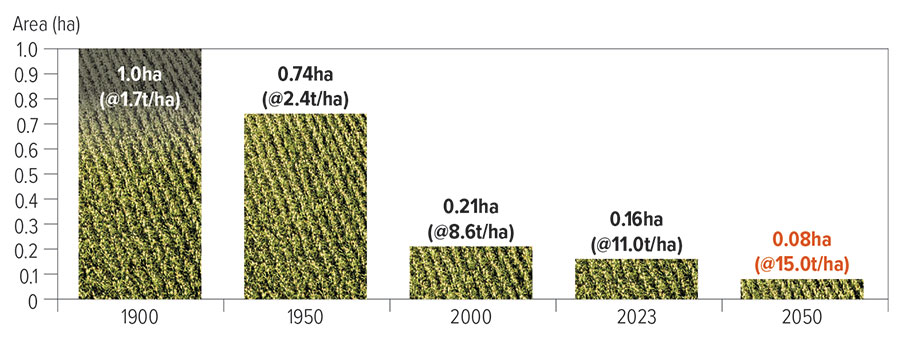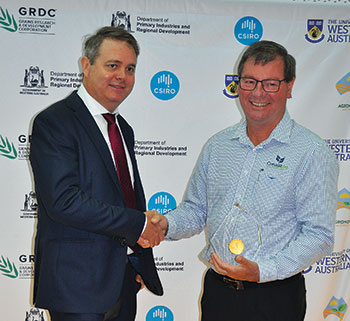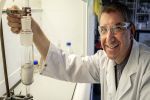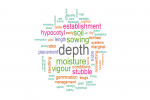Key points
- The 21st Agronomy Australia Conference was held in Albany in October 2024
- GRDC-sponsored keynote speaker Professor Raj Khosla, a precision agriculture specialist, spoke about the revolution in sensing
- Data collection is tipped to boost economic and environmental sustainability
- Career awareness is needed to attract more maths and computer scientists into agriculture
Soil sensors that can be thrown across a paddock like confetti or stuck to plants like wearable patches could soon be a reality on farms. Raj Khosla, Professor of Agronomy at Kansas State University and keynote speaker at the 21st Agronomy Australia Conference, outlined imminent advances in sensors and artificial intelligence.
“We are on the cusp of a revolution in sensors and sensing technology,” the precision agriculture expert told the audience.
“There will be rapid, reliable, diagnostic, non-destructive sensors available, and soil and crops will become the data points, creating the internet of soil or the internet of plants.”
Smart sensor
Professor Khosla spoke about sensors being developed by North Carolina State University that can be stuck (like wearable electronic patches) to the underside of leaves to detect viral and fungal infections before crops show actual symptoms.
They can also alert growers to other stresses, such as too much or too little water, lack of light or high salt concentrations in irrigation water.
Asking the audience if they had heard of ‘smart’ diapers, he gave further examples of where sensor innovation was heading. These diapers – or nappies – developed by Pennsylvania State University send a signal
to a smartphone when wet, helping in healthcare settings.
Professor Khosla said technology like this would flow to agriculture, in the same way that GPS developed initially for military use is now a part of everyday agriculture.
From human senses to high-tech sensors
He said sensors mimicked human senses and much thought had been funnelled into the optical type, particularly for weed control.
Researchers are beginning to explore other senses, such as acoustic sensing, as plants emit noise when water stressed. (Research has shown that when thirsty or stressed, plants generate ultrasonic sounds in the 20 to 100 kilohertz range.)
“But the value will not be in the sensors themselves, but in the data collected,” Professor Khosla said.
From Kansas to Albany
Professor Khosla travelled from the middle of the US, its agricultural heartland, to speak at Albany.
Known as the ‘wheat state’, Kansas also produces sorghum, soybeans, maize, canola, sunflowers, cotton, barley and alfalfa. Agriculture is a major contributor to the state’s gross domestic product and there are pressures to improve productivity and sustainability.
Kansas sits on one of the world’s largest aquifers – the Ogallala Aquifer. Professor Khosla said that if you have access to water, “you are a king … but the aquifer has been depleted by 60 per cent and that is not sustainable”.
Coupled with the US Department of Agriculture’s 2050 goal – to increase production by 40 per cent while decreasing agriculture’s environmental footprint by 50 per cent – sustainability is paramount.
While it might sound daunting, he explained how productivity had increased since 1900, with more grain being produced on less land (see Figure 1).
“Agriculture is complex and we are dealing with many systems, but data and data analytics is its future.”
Figure 1: Innovation highlighted in 'bushel' acreage.

Source: Professor Raj Khosla
Ending his presentation, Professor Khosla showed a graphic of where the future could lie via chat with his robot.
Karl, the grower: When should I irrigate this cornfield?
AI: Hi Karl. Let me ping the soil moisture sensors, weather towers and fork satellite data … It rained 19.2mm in the past five days, coupled with high temperature and corn plants are thirsty. Soil moisture sensors indicate that 5mm of water is still available to plants before stress level is reached. Plants will use an additional 10mm in the next two days. You can consider irrigation for tomorrow. 30mm would be sufficient.
Karl: I need a prescription map to upload it to irrigation laterals.
AI: A VRI prescription map is here. Do you allow me to upload in Precision Pivot? The satellite images also indicate nitrogen deficiency in the northern half of the field. Do you need a fertigation prescription to add to it?

Karl: I don’t think nitrogen sidedress is required!
AI: Based on the previous yield and current nitrogen state, it might reduce yield by 1.2 tonnes per hectare. Will you still consider not applying it?
Karl: Ok! Upload the prescription map along with the irrigation chart.
AI: It is now uploaded to the precision system. You can set a reminder.
Despite Professor Khosla’s take on the future, he said agronomy would still be an essential expertise. He said the industry was also reaching a time where “we don’t know how not to collect data”.
More maths and computer scientists will be needed in agriculture. GRDC sponsored the 2024 Australian Agronomy Conference and supported Professor Khosla’s attendance.
More information: Raj Khosla, rkhosla@ksu.edu
Read more at Precision sensors an innovative future for agriculture
New sensor enables smart diapers range other health monitors
Foz wins the Don
Renowned Western Australia agronomy consultant Geoff Fosbery – better known as ‘Foz’ – was awarded the 2024 CM Donald Medal, an award that celebrates eminent agriculturalists at the conference.
 Dr Ben Biddulph, president of the Australian Society of Agronomy with 2024 CM Donald Medal recipient Geoff Fosbery. Photo: supplied Agronomy Australia
Dr Ben Biddulph, president of the Australian Society of Agronomy with 2024 CM Donald Medal recipient Geoff Fosbery. Photo: supplied Agronomy Australia
Dr Ben Biddulph, president of the Australian Society of Agronomy, said Mr Fosbery was a pioneer of independent agronomy services in WA, starting a fee-for-service approach in the early 1990s. “A new concept, his enthusiasm and energy made him an invaluable asset to many in WA, blazing a trail for future consultants.”
Dr Biddulph said the landscape of agronomic consulting would look very different today without Mr Fosbery and his dedication to assisting farm businesses.
“Geoff started his career in 1981 at the WA Department of Agriculture’s Dryland Research Institute in Merredin. This was a time of great innovation, and a lot of research focused on developing better farming systems in areas with limited rainfall.
“During this time, Geoff was instrumental in identifying the impact of soil acidity on reducing productivity, honing his extension skills, and he became reputable for distilling messages from researchers to growers and encouraging on-farm adoption.
“Geoff has always been on the cutting edge of research, development and extension (RD&E) and is generous with his knowledge and experience. His constant pursuit of solutions has been exemplary,” Dr Biddulph said.
Geoff has an extraordinary ability to bring together separate pieces of research and observations from growers and develop robust production systems in challenging environments, and this has been invaluable for our RD&E sector.
Mr Fosbery received a GRDC Seed of Light Award in 2011, in recognition of going ‘above and beyond’ in his agricultural research and extension endeavours.
Other award winners at the conference included:
- CSIRO’s Dr Richard Simpson, who won the AW Howard Medal for his contribution to pasture advancement;
- Department of Primary Industries and Regional Development’s (DPIRD) Dr Mark Seymour and Australian Herbicide Resistance Initiative’s Professor Ken Flower, who became Fellows of the Australian Society of Agronomy;
- DPIRD’s Dr Brenton Leske, who won the Young Agronomist Award and a $5000 travel bursary from the society to attend an international conference or other professional development;
- Field Applied Research Australia’s Dr Max Bloomfield, who won the Best Early Career Paper for his paper on apical pruning; and
- Lipy Adhikar and Zhihao Tan, from the Queensland Alliance for Agriculture and Food Innovation, University of Queensland, who won travel bursaries of $2500 from the society.
More information: Agronomy Australia

























































